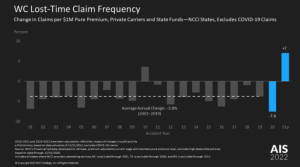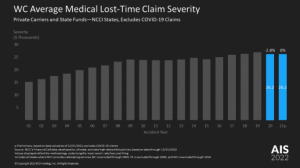Share This Article:
More details from NCCI Chief Actuary Donna Glenn’s presentation yesterday…
Claim costs are driven by employment, frequency (what percentage of workers gets hurt), the cost to provide medical care to those injured workers and the cost of paying their income benefits while off work.
While claim frequency bumped up in 2021, the increase just offset an almost-identical decrease in 2020. When you pull out the COVID stuff, the average annual decline in work comp claim frequency has been 3.8% over the last 20 + years.

This means – in three years there will be 11.4% fewer claims than there are today – that’s one out of ten claims.
Indemnity “severity” didn’t change last year compared to 2020, leveling off after a pretty consistent increase from 2016 to 2020.
Medical “severity” for loss time claims didn’t increase from 2020 from 2021 – it was dead flat – and has been pretty much flat since 2016.

Ed. note – while widely used in the work comp industry, the use of “severity” to describe what is nothing more than “cost” isn’t helpful. Medical severity should be a clinical measure, not a financial one. I would argue that the use of “severity” further distances the industry from increasing its understanding of the role of medical care in workers’ comp.
Glenn attributed the lack of movement in part to a shift to delivering care in outpatient facilities…more details to come in the final presentation today.
What does this mean for you?
Work comp medical costs are NOT increasing – my guess is the major progress most payers have made in reducing drug costs- and more specifically opioid over-use – has been a major help.
By Joe Paduda
Courtesy of Managed Care Matters
More by This Author
- Feb 10, 2025
- WorkersCompensation.com
- Oct 02, 2024
- WorkersCompensation.com
- Jun 24, 2024
- WorkersCompensation.com
Read More
- Mar 26, 2025
- Liz Carey
- Jan 30, 2025
- Liz Carey
- Aug 12, 2024
- Frank Ferreri
- Aug 06, 2024
- Frank Ferreri
- Aug 05, 2024
- Frank Ferreri




